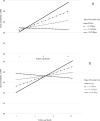Initial validation of a proxy indicator of functioning as a potential tool for establishing a clinically meaningful cocaine use outcome
- PMID: 28858744
- PMCID: PMC5611843
- DOI: 10.1016/j.drugalcdep.2017.07.020
Initial validation of a proxy indicator of functioning as a potential tool for establishing a clinically meaningful cocaine use outcome
Abstract
Background: Establishing a non-abstinence cocaine use outcome as clinically meaningful has been elusive, in part due to the lack of association between cocaine use outcomes and meaningful indicators of long-term functioning.
Methods: Using data pooled across 7 clinical trials evaluating treatments for cocaine (N=718), a dichotomous indicator of functioning was created to represent a meaningful outcome ('problem-free functioning' - PFF), defined as the absence of problems across non-substance-related domains on the Addiction Severity Index. Its validity was evaluated at multiple time points (baseline, end-of-treatment, terminal follow-up) and used to explore associations with cocaine use.
Results: The percentage of participants meeting PFF criteria increased over time (baseline=18%; end-of-treatment=32%; terminal follow-up=37%). At each time point, ANOVAs indicated those who met PFF criteria reported significantly less distress on the Brief Symptom Inventory and less perceived stress on the Perceived Stress Scale. Generalized linear models indicated categorical indices of self-reported cocaine use at the end of treatment were predictive of the probability of meeting PFF criteria during follow-up (β=-0.01, p<0.01; 95% CI: -0.008 to -0.003), with those reporting 0days or 1-4days ('occasional' use) in the final month of treatment showing an increased likelihood of achieving PFF.
Conclusions: Initial validation of a proxy indicator of problem-free functioning demonstrated criterion validity and sensitivity to change over time. Frequency of cocaine use in the final month of treatment was associated with PFF during follow-up, with strongest associations between PFF and abstinence or 'occasional' use.
Keywords: Addiction severity index; Clinically meaningful outcome; Cocaine; Functioning.
Copyright © 2017 Elsevier B.V. All rights reserved.
Conflict of interest statement
Author Carroll is a member of CBT4CBT, LLC, which makes CBT4CBT available to qualified clinical providers and organizations on a commercial basis. Dr. Carroll works with Yale University to manage any potential conflicts of interest. Authors Kiluk, Babuscio, and Nich declare no conflicts of interest.
Figures

Similar articles
-
Clinical validation of reduction in cocaine frequency level as an endpoint in clinical trials for cocaine use disorder.Drug Alcohol Depend. 2019 Dec 1;205:107648. doi: 10.1016/j.drugalcdep.2019.107648. Epub 2019 Oct 21. Drug Alcohol Depend. 2019. PMID: 31677490 Free PMC article.
-
Short and long-term improvements in psychiatric symptomatology to validate clinically meaningful treatment outcomes for cocaine use disorders.Drug Alcohol Depend. 2019 May 1;198:126-132. doi: 10.1016/j.drugalcdep.2019.01.046. Epub 2019 Mar 20. Drug Alcohol Depend. 2019. PMID: 30921648 Free PMC article.
-
Toward empirical identification of a clinically meaningful indicator of treatment outcome: features of candidate indicators and evaluation of sensitivity to treatment effects and relationship to one year follow up cocaine use outcomes.Drug Alcohol Depend. 2014 Apr 1;137:3-19. doi: 10.1016/j.drugalcdep.2014.01.012. Epub 2014 Jan 31. Drug Alcohol Depend. 2014. PMID: 24556275 Free PMC article. Review.
-
Detecting change in psychiatric functioning in clinical trials for cocaine use disorder: sensitivity of the Addiction Severity Index and Brief Symptom Inventory.Drug Alcohol Depend. 2021 Nov 1;228:109070. doi: 10.1016/j.drugalcdep.2021.109070. Epub 2021 Sep 20. Drug Alcohol Depend. 2021. PMID: 34600247 Free PMC article.
-
Auricular acupuncture in the treatment of cocaine/crack abuse: a review of the efficacy, the use of the National Acupuncture Detoxification Association protocol, and the selection of sham points.J Altern Complement Med. 2004 Dec;10(6):985-1000. doi: 10.1089/acm.2004.10.985. J Altern Complement Med. 2004. PMID: 15673993 Review.
Cited by
-
Sociodemographic and clinical outcome differences among individuals seeking treatment for cocaine use disorders. The intersection of gender and race.J Subst Abuse Treat. 2019 Nov;106:65-72. doi: 10.1016/j.jsat.2019.08.014. Epub 2019 Aug 28. J Subst Abuse Treat. 2019. PMID: 31540613 Free PMC article.
-
Contingency management for treatment attendance: A meta-analysis.J Subst Abuse Treat. 2022 Feb;133:108556. doi: 10.1016/j.jsat.2021.108556. Epub 2021 Jun 24. J Subst Abuse Treat. 2022. PMID: 34210566 Free PMC article.
-
Reduced drug use as an alternative valid outcome in individuals with stimulant use disorders: Findings from 13 multisite randomized clinical trials.Addiction. 2024 May;119(5):833-843. doi: 10.1111/add.16409. Epub 2024 Jan 10. Addiction. 2024. PMID: 38197836 Free PMC article. Clinical Trial.
-
Examining cocaine use reductions and long-term outcomes in two clinical trials of continuing care for cocaine dependence.J Subst Use Addict Treat. 2024 Aug;163:209394. doi: 10.1016/j.josat.2024.209394. Epub 2024 May 11. J Subst Use Addict Treat. 2024. PMID: 38735481 Free PMC article. Clinical Trial.
-
Clinical validation of reduction in cocaine frequency level as an endpoint in clinical trials for cocaine use disorder.Drug Alcohol Depend. 2019 Dec 1;205:107648. doi: 10.1016/j.drugalcdep.2019.107648. Epub 2019 Oct 21. Drug Alcohol Depend. 2019. PMID: 31677490 Free PMC article.
References
-
- Alterman AI, McDermott PA, Cook TG, Cacciola JS, McKay JR, McLellan AT, Rutherford MJ. Generalizability of the clinical dimensions of the Addiction Severity Index to nonopioid-dependent patients. Psychol. Addict. Behav. 2000;14:287–294. - PubMed
-
- American Psychiatric Association. Diagnostic and Statistical Manual of Mental Disorders. Fourth. APA Press; Washington DC: 1994.
-
- Bovasso GB, Alterman AI, Cacciola JS, Cook TG. Predictive validity of the Addiction Severity Index’s composite scores in the assessment of 2-year outcomes in a methadone maintenance population. Psychol. Addict. Behav. 2001;15:171–176. - PubMed
-
- Calsyn DA, Saxon AJ, Bush KR, Howell DN, Baer JS, Sloan KL, Malte CA, Kivlahan DR. The Addiction Severity Index medical and psychiatric composite scores measure similar domains as the SF-36 in substance-dependent veterans: concurrent and discriminant validity. Drug Alcohol Depend. 2004;76:165–171. - PubMed
-
- Carroll KM, Nich C, Ball SA, McCance-Katz E, Rounsaville BJ. Treatment of cocaine and alcohol dependence with psychotherapy and disulfiram. Addiction. 1998;93:713–728. - PubMed
MeSH terms
Substances
Grants and funding
LinkOut - more resources
Full Text Sources
Other Literature Sources
Medical
Miscellaneous

